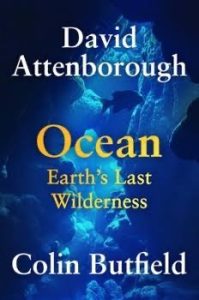Grand Central, New York & London
Review by Rasoul Sorkhabi

David Attenborough, the world-famed BBC broadcaster and writer of nature documentaries, celebrated his 99th birthday on May 6th this year. On this occasion, Attenborough’s latest film Ocean premiered in the Royal Festival Hall in London. In the US, the film streamed on Disney+ and Hulu on June 8th coinciding with World Ocean Day. A companion book Ocean: Earth’s Last Wilderness has been published, which is Attenborough’s 30th book. Although co-authored by Colin Butfield, a co-director of the film Ocean, the book’s driving force is Attenborough.
Attenborough recalls that his first encounter with the “ocean” was through ammonite fossils which he collected from an old limestone quarry in Leicestershire, England in the 1930s. A century later and after a lifelong exploration of our planet, Attenborough believes that “Ocean is a far more appropriate name for our world than Earth.” Oceans cover about 72 percent of Earth’s surface area and contain 94 percent of the planet’s water budget. Attenborough and Butfield have named the new book and film Ocean rather than Oceans because all oceans are a single interconnected water body. The longest mammal migration does not occur on land but in the ocean by humpback whales travelling 80,000 kilometers.
Ocean: Earth’s Last Wilderness consists of three parts. Part One, a single chapter, is an imaginative story of a blue whale in the Gulf of California, which Attenborough filmed for the 2001 documentary The Life of Mammals. Attenborough remarks that the life span of this blue whale, about ninety years, is equal to that of “our journey of modern ocean discovery.”
The “meat” of the book is Part Two, which through eight chapters takes the reader on a planetary voyage exploring myriad marine life forms in various habitats – from coral reefs, kelp forests and mangroves to the abyss, islands, seamounts, and polar seas.
Attenborough was once a skeptic of global warming, but changed his mind and became an advocate for ecological sustainability through first-hand observation of how global warming has adversely affected marine life. He details the evolution of this thinking in the new book. He recalls that in 1957 he made his first scuba dive on the Great Barrier Reef while making a film about Australia. Coral reefs are “where we find the most dazzling array of life anywhere in the world’s ocean.” Later field trips demonstrated how the Great Barrier Reef – the largest of its kind – and other coral reefs had been damaged by climate change and pollution. “In my lifetime,” Attenborough remarks, “the world has lost over half of its coral.”
Coral reefs form a delicate and balanced coexistence of carbonate minerals, tiny boneless animals related to jellyfish called coral polyps, and a type of algae plant called zooxanthellae that covers the coral colony. They display a beautiful symbiosis and create a supportive habitat for various marine species. Nearly 76 percent of the world’s coral reefs are located in the Coral Triangle surrounded by the Philippines, Malaysia, Indonesia, and Papua New Guinea. Sizeable coral reefs are also found in the Caribbean.
Two separate chapters are devoted to The Arctic and the Southern Ocean. The Arctic Ocean is centered around the North Pole and surrounded by five countries (Russia, Denmark, Norway, Canada, USA). It is the smallest of all oceans. The Southern Ocean is like a thick ring of ice circling the Antarctic continent. It is the youngest of all oceans in the sense that the southern tip of South America became detached from the arm of West Antarctica some 30 million years ago. Polar oceans absorb more atmospheric carbon dioxide than tropical oceans because carbon dioxide is more soluble in cold water. Moreover, the polar ice caps, which account for 99 percent of all glaciers on Earth, are sensitive to global warming.
In the Epilogue the authors warn of the consequences of ocean acidification, overfishing, plastic and other types of pollution that are destroying marine life. However, they also note that with global awareness, willingness and cooperation “the ocean can recover; mangroves and kelp forests can regrow, whales can return and dying coastal communities can flourish once again.”
Despite the massive environmental stress exerted on the oceans, Attenborough and Butfield see some signs of hope. For instance, international bans on commercial whaling and sealing have increased the populations of these sea creatures. The 1959 Antarctic Treaty that set aside Antarctica as a continent for science inspired a 1982 convention to extend international protection to Antarctic marine ecosystems. The Cabo Pulmo National Park in Baja California created through coordinated efforts by local communities, scientists and officials revived the once dying coral reefs in the Gulf of California.
Reading Ocean by Attenborough and Butfiled reminded me of Rachel Carson’s The Sea Around Us which I had read as a student years ago. In a 1961 pocket edition of the book, Carson writes: “The sea has always challenged the minds and imagination of men and even today it remains the last great frontier.” Humans do not live in water, but the health of terrestrial life depends on the oceans. Humanity, Attenborough and Butfield conclude, must protect this last and “greatest wilderness of all.”
Rasoul Sorkhabi is a professor of Geology at the University of Utah. His previous book review in the California Review of Books was on water.
